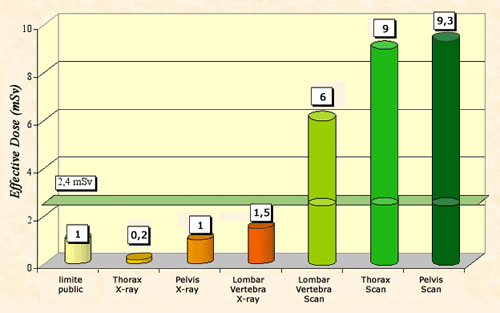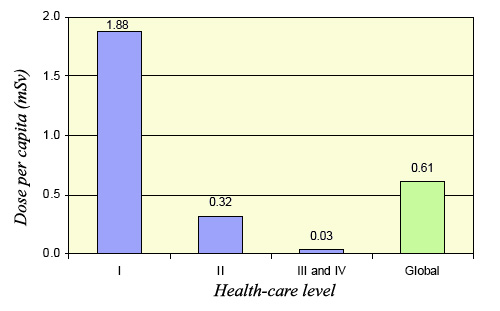The main exposure from man-made radiation

Radiation exposures from X-rays scan
Doses delivered during various radiological examinations, compared to the average annual exposure to natural radioactivity in France. The doses received for scanners exceed several times the legal limit of 1 millisievert for exposures excluding natural radioactivity and medicine.
© IN2P3
Apart from natural radioactivity, the main source of radiation exposure is due to medical diagnostics and therapies. Exposure to radiations coming from X-Rays or nuclear medicine diagnostics, varies greatly depending on the patient health status : from 0 for a person who never sees a doctor to tens of millisieverts (mSv) for a someone who has to undergo several CT-Scans.
Irradiation in medicine is much more due to the use of x-rays for radiographies than to radioactivity itself. It is more accurate to speak of radiation than of radioactivity, even if the logo of radioactivity adorn radiologists’ cabinets (NB: in the eyes of physicists, X-rays from the inner atomic layers are not “radioactive”) ! For the patient as for the doctor, it is the effect of radiation and not their origin that counts. Therefore, doctors and radiobiologists do not make distinctions.
The X-rays used ior diagnostics are rarely atomic. The gamma rays of a CT-scanner come from a small accelerator, which allows a better steering. In the case of nuclear diagnostics, such as scintigraphies the rays are gamma coming from radioactive decays. But whether X or gamma rays, their detection are similar.
In therapies – radiotherapies or nuclear therapies – the impact of ionizing radiation is used. All radiations, whatever their origin, end up depositing their energy by “ionizing” living matter. Radiation therapists use gamma rays of a few MeV produced by an accelerator, often called x-rays. In nuclear therapies, radiation can be of radioactive origin such as brachytherapies, or provided by an accelerator in the case of advanced therapies such as proton therapies.

Average exposures due to medical and dental diagnostics
Average annual exposure to ionizing radiation resulting from dental and medical diagnostics. Level 1 corresponds to the most developed countries, levels III and IV to the least developed ones. The disparity is very important. The numbers are extracted from the UNSCEAR 2008 report and refer to the period 1997-2008. During this period, medical exposure of 1.88 millisievert (mSv) has nearly caught up the 2.4 mSv exposure to natural radioactivity in a country like France.
© 2008 UNSCEAR report on the Effects of Atomic Radiation
Today, nobody would question the progress of medicine that has the effect of extending the human life span. The progress is largely due X-ray exposures, from simple X-rays to recent CT-scans and today’s nuclear medicine. Over the years, the development of increasingly sensitive detectors has also reduced the amount radiation exposure required for the same quality of results.
In developed countries these procedures accounts in 2008 for more than 40% of the total exposure to radiations . They are by far the most significant source due to man. In developing countries, however, medical exams account for as little as 1.5% of the total exposure to radiations. Worldwide, the number of dental or medical acts involving X-rays amounted to 3.6 billion per year during the decade 1997-2007, an increase of 50% over the years 1991-1996.
In Belgium, the life expectancy in 1900 was of 48 years for men and 51 for women. In one century, these numbers have jumped to 74 and 80 years respectively thanks to a massively improved healthcare system. In the same period, the levels of radiation almost doubled from 2.3 mSv to 4.5 mSv as a result of the institution of medical radiation scans. In total, the exposure felt during a Belgian’s lifetime has tripled – going from 110 mSv in 1899 to 338 mSv in 1999 for men, and from 117 to 360 mSv for women.
This animation by UK not-for-profit Nuffield Health shows just how little radiation medical scans expose us to by comparing the levels to natural background radiation, air travel and even space travel. Produced with the help of the Radiological Protection Centre in London.
Link to Nuffield Health web site